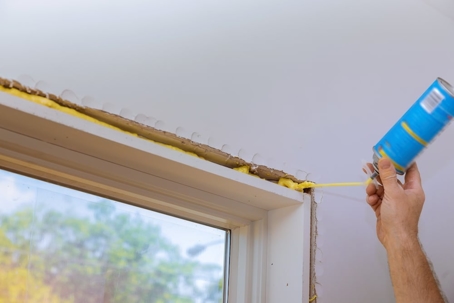If you’re considering replacing your home’s windows, you want to ensure it’s done right the first time.
Whether looking to hire a professional contractor or choosing to replace the window yourself, you want to be educated on the right installation practices.
A large part of this is understanding the steps of a high-quality window replacement and knowing what tools and products to use for the best results.
From proper removal techniques to the type of nails and caulk used, understanding best installation practices helps you know exactly what to look for in a contractor or at a hardware store.
So, you don’t just want to know the best practices for a high-quality window installation, but you want to get into the nitty-gritty details.
What type of caulk should be used? What type of nails should be used? How do you properly remove the trim around a window? What kind of foam should be used to insulate around the window?
These are all questions you may want answers to to make the best decision for your project.
Southwest Exteriors has been a window replacement contractor in San Antonio since 1989. Our expert installation crews use the best techniques and highest quality products for a window replacement.
Your new windows will be installed to last a lifetime in your home and will be backed by our lifetime warranty.
To insulate the windows we install, we use spray foam around the windows. We use this type of foam because it creates the tightest seal around windows, ensuring no water or air leaks through the sides and creating a stable and balanced window.
But, we know this is not the only option for insulation out there, and you may be curious how other foam insulators compare to one another.
This article will compare spray foam and premade foam for window insulation. We will define what each of these types of foam is and dive into their pros and cons.
After reading, you’ll know what each type of these foams is and how they perform as a window insulator. Then, you can accurately compare the two and determine which you prefer for your new windows.
This, in turn, will allow you to make the best choices for finding the right contractor that uses the products you want and will meet your goals for your window replacement.
Spray Foam vs. Foam Strips Window Insulation: What Are They?
When it comes to insulating your home’s windows, a few products and techniques can be used, like fiberglass insulation, spray foam, and foam strips.
While they all have the same purpose and goal, they perform differently, resulting in differing outcomes.
If you’re looking to hire a professional for your window replacement or just want to add some insulation to your current windows, you want to choose the best product for the job.
Here, we’ll define spray foam and foam strips for window insulation and look into some of the specs that come with them.
What Is Insulating Spray Foam?
Most spray foams are made of an isocyanate and polyol resin. Think of it as two chemical elements mixing and creating a reaction. (Simple science, right?)
In other words, the polyol resin and isocyanate, when combined, create a reaction that releases gas. This allows the spray foam to expand when released from the can.
How Does Spray Foam Work?
Spray foam may also be referred to as an expanding foam because most spray foams are expanding.
When the foam is sprayed out of the can, it will continue to expand in size anywhere from 15 to 30 minutes upon release. The foam essentially expands until it finds a surface that stops it.
This allows the foam to create a tight seal wherever it is placed.
What Are Insulating Foam Strips?
Insulating foam strips are typically made of a PVC material (polyvinyl chloride) and a rubber. These two ingredients make for a flexible foam material that is able to stretch and squeeze into small gaps to create a seal.
Think of foam strips similar to a pool noodle. You can squeeze them and make them as small as possible, and they will still bounce back to their original shape.
How Do Insulating Foam Strips Work?
Foam strips, like pool noodles, are squishy and flexible. You can compress and stuff them into small surfaces; then, they will expand to try and get back to their original shape, creating a tight seal within the space.
Insulating foam strips can also be referred to as weather stripping. They can either go around the gap of the window and wall frame or on the exterior of the window to create a seal when closed.
Spray Foam vs. Foam Strips: How Do They Compare in Their Material and Performance?
When looking at the material and performance of spray foam and foam strips for window insulation, you can start to compare how they will work on your window.
Spray foam is reliable for fitting into any small cracks, crevices, and gaps between your window and the wall. This ensures no air or moisture can get past your window, causing drafts or rotting.
Foam strips or weather stripping provide a different kind of insulation for your window. They are typically used more for the exterior of the window to protect any seams around the frame when installed.
If you want better insulation for your newly installed windows, you will want an expanding spray foam. If you want to add more insulation and protection to your older windows, foam strip insulation is an easy way to strengthen the seal between your windows and the exterior.
Spray Foam vs. Foam Strips Window Insulation: Pros and Cons
After learning more about what each type of window insulation is and how they perform, you want to know what the pros and cons are.
What are the benefits of these types of insulation? Are there any disadvantages to them? Will they meet all your needs for your windows?
Let’s look more into a few benefits and drawbacks of spray foam and foam strips for window insulation.
Pros and Cons of Spray Foam for Window Insulation
Expanding spray foam is one of the best insulating options to surround new windows with. There are many benefits of expanding spray foam insulation.
But, like with any product, there are some potential drawbacks you want to be aware of.
Pros of Spray Foam Insulation
Some of the benefits of using an expanding spray foam insulation are:
- Creates an airtight and watertight seal around the window
- Hardens to create a firm, strong bond around the window
- It is inexpensive if you DIY your window insulation ($4 - $10 per can starting cost)
Cons of Spray Foam Insulation
Some of the potential drawbacks of expanding spray foam insulation are:
- Quick cure time can make it difficult to install
- Rapid expansion can make it easy to overfill gaps, making for a messy installation
- It can damage the surrounding wall when removed (if overfilled)
Pros and Cons of Foam Strip Window Insulation
Foam strip window insulation has its benefits and potential drawbacks, just like spray foam insulation.
Pros of Foam Strip Insulation
Some of the benefits of foam strip insulation are:
- Peel and stick strips make for easy and quick installation
- It is an inexpensive material ($15 - $20 starting cost for 20 ft. length of foam)
Cons of Foam Strip Insulation
Some of the potential drawbacks of foam strip insulation are:
- It is not as long-lasting as spray foam insulation
- It can still allow air and water to pass through if not installed properly
- It is not a long-term solution for drafty or leaky windows
Spray Foam vs. Foam Strip Window Insulation: How Do Their Pros and Cons Compare?
Spray foam and foam strip insulations have similar pros and cons. They are both relatively inexpensive materials to buy if you plan to do your project yourself.
Spray foam insulation provides an air and watertight seal around your window. Foam strip insulation can still leave room for gaps, which can let air and water pass through your window.
Spray Foam vs. Foam Strip Window Insulation: Which is better?
Now that you know more about spray foam and foam strip window insulation, what they are made of, and their pros and cons, you have a better idea of how they perform and which is better for your windows.
If you are having your windows professionally replaced, you will want to find a contractor that uses expanding spray foam around the window. This will best secure the window and protect it from any air or water infiltration.
Spray foam is also DIY friendly if your windows have no prior insulation, though it does require removing and reinstalling the trim around your windows.
Foam strips are a good insulator on the exterior around the window. It is easy to install and can cover cracks forming around the sides of the window as well as drafts around the top or bottom of the window sashes.
However, foam strips for internal window insulation are not the greatest option. They will not provide as tight of a seal as expanding spray foam and are better as a short-term solution.
With Southwest Exteriors, we use expanding spray foam when installing our high-quality windows.
Our professional installers follow all the best practices for window installations, so your new windows will keep your home protected from air, weather, and water.
If your windows are drafty or you notice water forming around the sill, chances are you need a contractor that knows the proper way to fix it.
You need a contractor that will use the best products so your windows will last for years in your home. So, you want to learn more about proper installation practices and what you may encounter if your windows aren’t installed correctly.
Then, you can find the right contractor that knows what they are doing to avoid these problems.


